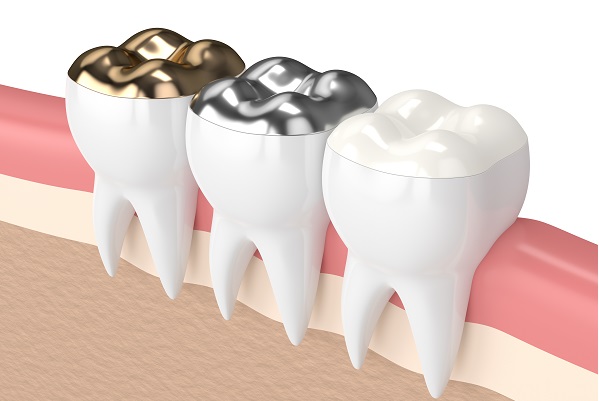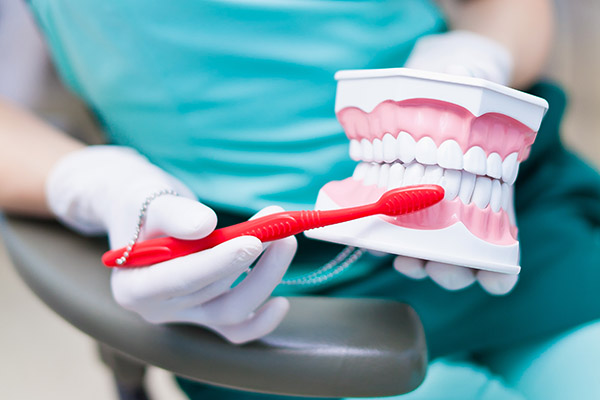When Is a Dental Filling Necessary?

If you have ever gotten a cavity, you most likely had it filled with a dental filling. Dental fillings are used to fill the space left by a cavity.
When is a dental filling necessary?
The recommended time for a dental filling is when your dentist detects the beginnings of tooth decay and not when you notice a hole in your tooth. Several steps lead to tooth decay, and you may experience symptoms before the cavity forms.
The first stage of tooth decay is when the enamel on your teeth erodes. Enamel is the outer layer of your tooth that protects it from harm, and it is constantly bombarded with bacteria that cause it to wear down. When carbohydrates mix with saliva in the mouth, bacteria form that attack the enamel. If these bacteria are not removed with regular brushing and flossing, the enamel may deteriorate to the point that the dentin is exposed. If bacteria reach the dentin, tooth decay results, and you will begin to notice the symptoms of a cavity. These include:
- Toothache
- Pain when eating or drinking sweet things
- Stains on the teeth
- Pain when biting down
- Hot or cold sensitivity
If you experience any of these, a cavity is likely to form. Consult a dentist if you experience any of these symptoms. They may be able to minimize your need for a filling.
What if you experience pain after getting a dental filling?
While you can expect to feel some pain after getting a dental filling, it should not last more than a day or two. However, if you continue to experience pain, there are some common causes.
Composite fillings are known to cause sensitivity. It is fairly common for a composite filling to shrink, which causes a gap beneath it. If this becomes too uncomfortable to cope with, your dentist may replace it with a different material or alter the method used to install it.
If the filling is not positioned correctly, you may experience malocclusion. This refers to a filling that is placed too high, which causes pain when you bite down. This can be easily fixed with a follow-up visit to your dentist.
Rarely, an electric shock may occur if you have both amalgam and gold fillings that touch. The metals might combine to form an electric current.
What are the different types of fillings?
Fillings generally come in two varieties: metallic and non-metallic. In general, metallic fillings such as gold and amalgam are more durable than non-metallic fillings and can last up to 20 years before needing to be replaced, but they do not have the natural color of teeth. This makes them ideal for back teeth where they are less noticeable, and their durability means they can withstand chewing. Non-metallic fillings such as porcelain, composite, and glass ionomer look like natural teeth but are generally less durable than metallic fillings, making them typically more appropriate for front teeth.
Dental amalgam is a common type of metal filling. They are silver in color and contain a mixture of different metals including tin, copper, silver, and mercury. Mercury is a key component because it reacts with the other metals and binds them into a highly durable material.
Another type of metal filling is gold. Also called inlays or onlays, they are highly durable, just like dental amalgam. However, they are less popular than dental amalgam, and it is not guaranteed that your dentist will be able to install gold fillings.
Composite fillings are non-metallic. Made of a mixture of resin and glass, they are less durable than their metal counterparts and need to be replaced more often, but have a natural color.
Glass ionomer is another type of non-metallic filling. Made of powdered glass, they are an alternative to composite fillings if you are looking for natural color. One special feature of glass ionomer fillings is that they may release fluoride, which will strengthen your teeth and help protect them from cavities.
Because amalgam fillings contain mercury, you may have concerns about their safety. Rest assured that they are not harmful, as they do not contain the type of mercury that is toxic to humans.
Before receiving a filling, tell your dentist if you are allergic to anything that might be in a metal filling, such as copper or tin. Some people have allergies that prevent them from getting metal fillings.
Conclusion
A dental filling is a common and effective way to reduce or eliminate pain caused by a cavity. Because there are many different types of fillings used for different scenarios, you will likely have choices as to what kind of filling you can receive.
Request an appointment here: https://www.alluredentalchicago.com or call Allure Dental at (312) 248-7517 for an appointment in our Chicago office.
Check out what others are saying about our dental services on Yelp: Composite Fillings in Chicago, IL.
Recent Posts
Many people do not want to get dental fillings. The idea of sitting in the dental treatment chair can be intimidating, especially for those who had bad experiences with dentists. Fillings can improve the health of your teeth. Having them can help you keep your teeth longer. If you want to know what you should…
You can enhance your smile with cosmetic dentistry treatments. If you are considering one or more cosmetic dentistry procedures to improve your smile, read on to learn more.By learning more about cosmetic dentistry and the benefits treatment offers, you can decide if a treatment plan is right for you. The following are some things to…
One of the treatment options a cosmetic dentist may employ to improve the appearance of a person's smile is dental bonding. Also known as tooth bonding, dental bonding is a procedure that involves applying a tooth-colored resin to the teeth to achieve the desired result. When a cosmetic dentist performs dental bonding, the dentist applies…
When it comes to enhancing a patient's smile, a cosmetic dentist may utilize a variety of treatment options to achieve the desired look. One of the most commonly used procedures in cosmetic dentistry is applying veneers to teeth that are permanently discolored, irregularly sized or shaped, or unevenly spaced in the mouth. While this technique…


